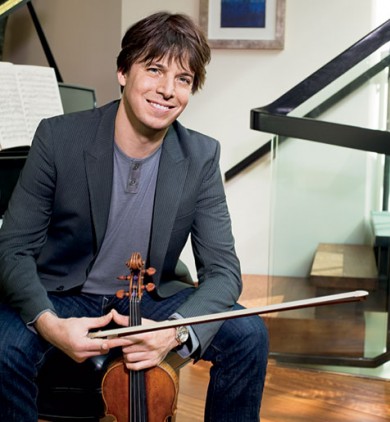Joshua Bell captivates Kravis Center with Romantic program

Joshua Bell performed a recital Tuesday afternoon at the Kravis Center in West Palm Beach.
Joshua Bell captivated a large audience with a virtuosic recital for the Regional Arts series Tuesday afternoon at the Kravis Center. Bell has mastered this type of audience-friendly program — romantic violin sonatas, a touch of early twentieth century music and a no-holds-barred showpiece for an encore.
Bell limbed the classical symmetry of Mendelssohn’s posthumously discovered Violin Sonata in F Major, producing silken tone in the central Adagio. Reminiscent of Mendelssohn’s Songs Without Words, this slow intermezzo framed two rapidly paced movements in which Bell’s performance lacked nothing in fire or spark. Indeed his passionate involvement with every bar considerably elevated the score from mere footnote status.
Brahms’ Violin Sonata No. 3 in D minor is standard recital repertoire but Bell offered a fresh interpretive approach. The opening Allegro was taken at a daringly fast tempo, played with spare vibrato and Bell emphasized the agitato marking of the concluding Presto. The scherzo sounded unusually macabre and eerie. Only in the lyrical outpouring of the Adagio did Bell bask in the music’s romantic glow. Instead of the usual prettified ruminations, the entire performance suggested a link between late Brahms and early Mahler, a stimulating reinvention of overplayed fare.
While musically expressive, pianist Sam Haywood lacks the subtlety of Jeremy Denk, Bell’s frequent keyboard partner. Burdened with a dull-sounding instrument, Haywood at times was overly emphatic, his accompaniment not always cohesive. In the program’s second half, he seemed more at home in the music of Gershwin and Ravel. Still the Bell-Haywood partnership remains a work in progress.
Eugene Ysaye’s unaccompanied Sonata in D minor, Op. 27, No.3 (Ballade) is a technical tour de force that makes Paganini’s caprices sound like mere warmup exercises. Double stops, pedal points, wild leaps between the instrument’s highest and lowest registers, and reams of counterpoint add spice to a chromatic phantasmagoria with musical allusions to Bach for good measure. This mashup found Bell in high gear, reveling in the dazzling technical display while bringing heart-on-sleeve passion to this emotionally volatile showpiece. (In pre-performance comments, Bell noted that his teacher Josef Gingold studied with Ysaye so he feels an artistic kinship with the Belgian violinist-composer.)
Bell breezed through Jascha Heifetz’s transcriptions of Gershwin’s Three Preludes, bright and fleet in the two fast pieces, turning the Andante into a poetic blues ballad. Ravel’s Sonata in G Major, his final chamber work, bears no little influence from Gershwin. No longer the impressionistic colorist, Ravel fashioned an austere sonata with vivid outbursts of the American jazz sounds that were sweeping Paris in the 1920’s. Bell’s light touch channeled the Gallic verve of the opening Allegretto, the instrumental lines wonderfully transparent with Haywood making his best effort of the afternoon. Bell accented the bluesy slides and blue notes in the Moderato with the aplomb of Stephane Grappelli. His breakneck pace set the Perpetual mobile finale aloft. For sheer instrumental color and finesse, Bell’s Ravel sonata performance would be hard to surpass.
For his encore, Bell offered a high gloss reading of Sarasate’s Zigeunerweisen (Gypsy Airs). In the muted middle episode, Bell’s sweet, caressing tone soared in the wistful gypsy lament.
Bell has an undeniable knack for conceiving crowd-pleasing programs. Hopefully in the future he will venture further afield and offer more recent repertoire, outside his audience’s comfort zone. In the past, Bell has championed contemporary violin concertos by John Corigliano and Nicholas Maw. Some of that same enterprising spirit would be welcome on his recital programs as well.
Posted in Performances
Leave a Comment
Wed Feb 1, 2012
at 9:53 am
No Comments






